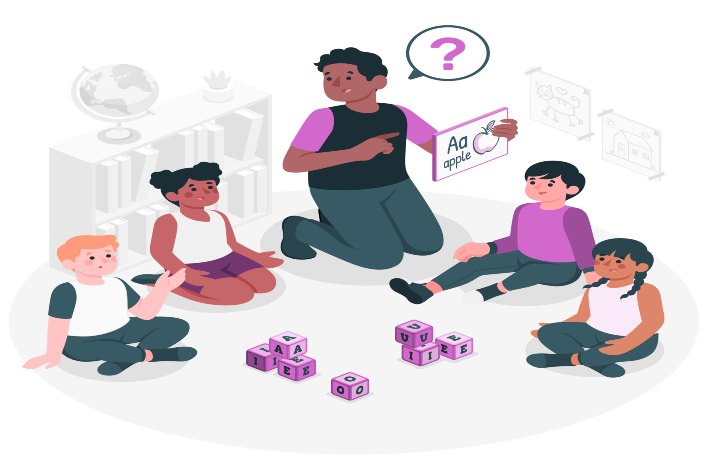How Play-Based Learning Enhances Creativity Among Young Children?

Play-based learning is one of the innovative teaching methods that are dependent upon the young child's curiosity and imagination in the early years of education. In the case of play-based learning, young children, through playful activities, explore the world, test ideas for themselves, and express themselves freely. The article will cover what is play-based learning, its importance, the types of activities involved in it, and the development of creativity in young children through it. We also will be looking at the challenges that educators face in implementing this type of learning, particularly in formal educational settings.
What is Play-Based Learning?
The approach to learning through play is one whereby the means through which children learn are focused principally on playing. This allows them the opportunity to explore, discover, and make sense of the world in a way that comes naturally and effortlessly to them. The more traditional forms of learning, often characterized by structured lessons and direct instruction, take a back seat to this child-centered, play-based approach, which invites participation.
A wide set of play-based learning activities among children involves role-playing, drawing, constructing with blocks, and playing imaginative games. All these play activities are specially designed to focus on the cognitive, social, emotional, and physical development of the child. For example, while children build with building blocks, they play by developing their spatial awareness, fine motor skills, and problem-solving skills.
Why is Play-Based Learning So Important?
Play-based learning in kindergarten is important in the overall development of a young child. It develops creativity, critical thinking, and problem-solving skills—qualities much needed to thrive in today's world. Here are some reasons why play-based learning in kindergarten is so essential:
1. Develops Imagination and Creativity:
Playing enables the child to start using his imagination, upon which creativity develops. Be it acting like superheroes, building a castle, or picture drawing, children use their creativity to explore possibilities and find solutions. This is a form of imaginative play that helps them think out of the box to come up with something innovative.
2. Cognitive Development:
Playing helps children develop some basic cognitive capabilities, including memory, attention, and reasoning. For example, while playing with jigsaw or sorting puzzles, children learn to identify patterns, categorize objects, and draw inferences about solving these problems. Such activities lay the very foundation for even more daunting cognitive feats later in life.
3. Development of Social and Emotional Competencies:
This mode of learning further assists children in the development of social skills, such as communication, cooperation, and empathy. While playing together, children share, take turns, and resolve conflicts. These interactions are crucial for their emotional development and help them establish good relations with other people.
4. Supports the Development of Physical Development:
Most activities associated with the play-based approach to learning concern physical movements, like running, jumping, or climbing. These activities enhance the gross motor skills, coordination, and balance of children. Similarly, fine motor skills, like hand-eye coordination, develop through drawing, cutting, or manipulating small objects.
5. Love for Learning:
When children learn through play, they relate learning to having fun and enjoying themselves. Such an attitude can make them motivated to explore new ideas, face challenges, and foster a lifelong love for learning.
Play-Based Learning in Kindergarten
Play-based learning is particularly effective in easing the transition from home to kindergarten, the period when children start adapting to a more regular and disciplined environment. This transition will be easier with play-based learning in kindergarten as the setting is what many children are used to and are comfortable with.
Most of the kindergarten play-based learning activities combine both guided and free play. For instance, teachers prepare activity stations containing different materials that children will be working with, such as art supplies, building blocks, and sensory tables. These stations give children the latitude to select the most interesting thing to themselves, and hence such activities foster independence and self-initiated learning.
In kindergarten, the teachers are facilitators during this play-based learning. They observe the children while they are at play, pose open-ended questions to them, and provide materials that provoke further investigation. This guidance allows them to understand how their experience in playing relates to wider concepts in learning.
For example, a teacher may ask a child to count how many items are in their shopping basket or discuss healthy eating during a pretend play activity in a mock store. Through these types of activities, children can build emerging literacy and numeracy skills within a meaningful and familiar context.
How Creativity is Enhanced through the Approach of Play-Based Learning
Creativity is something essential that can be developed from very tender years through play-based learning. Here's how this approach develops creativity in children:
1. Freedom to Explore:
This play-based learning gives children the freedom to explore their interests and ideas without the constraints of structured lessons. This freedom provides them with the ability to experiment with various materials, scenarios, and outcomes, essentially all components of creative thinking.
2. Risk-Taking Encouraged:
Creativity generally includes taking a risk and trying out something new. In a play-based learning environment, there is no right or wrong way to play, and children feel safe taking risks. This will make them more creative and encourage them to come out with their particular solution to a problem.
3. Spurs Imagination:
Most of the time, during play-based learning activities, there is always time left for imaginative play where children innovate stories, characters, and scenarios. This kind of play spurs their imagination to think creatively. For example, whenever children enact pretend play, for instance, being a doctor or a chef, they imagine different roles and responsibilities that help to develop their creative thinking.
4. Problem-Solving Opportunities:
Problem-solving opportunities arise during various situations at play. It could be to find the right method of constructing a strong tower using blocks or sharing a favorite toy with others; children come up with creative solutions to keep the idea flowing.
5. Encourages Collaboration:
Most of the play-based learning activities are based on collaboration with others. In this process, when children collaborate towards creating something, a fort, or a play, the ideas get across and children learn from each other. Such a collaborative process instills creativity and helps children build on their creative skills within a social context.
Challenges of Play-Based Learning

While there are definite benefits to play-based learning, several challenges are related to the successful execution of this approach.
1. Formal Education Settings:
This is a very critical balance that has to be drawn between the need for playful engagement on the part of the young child and the developing academic imperatives placed upon them. This, in many educational systems, encourages a thorough emphasis on accountable outcomes, such as literacy and numeracy competencies, at the cost of playing.
2. Inadequate Training of Educators:
Play-based learning is specialized training for educators dealing with knowledge in child development and play pedagogy. Perhaps, many teachers have not been subjected to this particular training and hence struggle in facilitating the approach of play-based learning.
3. Limited Resources:
Play-based learning very often requires several materials and resources, such as art supplies, building blocks, and outdoor play equipment. These resources are sometimes limited in certain settings and make real provision for a rich, play-based learning environment difficult.
4. Parental Expectations:
Views concerning the role of play as a significant avenue for children's learning are varied among parents. Other parents might instead expect academic performances rather than playful learning and thus may be skeptical about how effective play-based learning is. Educators have to communicate the benefits of play-based learning to parents and involve them in the process.
5. Challenges to Assessment:
Assessing the results of play-based learning is challenging as the learning occurring during play is usually far less concrete and, therefore, harder to measure than the more 'academic' traditional skills. New assessment methods have to be devised by educators capable of capturing the full range of the children's learning and development through play.
Conclusion
The mighty tool in early childhood education is learning through play. It develops creativity, critical thinking, and problem-solving skills in young children. By giving the child the opportunity to learn through play, educators create a dynamic, engaging learning environment that instills a love of learning and sets up children for future success. Any actual gains from this form of learning will only come when the implementation challenges are taken into consideration and solved, including balancing academic expectations, providing adequate resources, and also training educators in the method and practice of play.
Learning through play has become a significant help to boosters in improving the capability of the youth in creativity and innovation during the present century. We should open our door to the philosophy of making children creative, confident, and capable individuals to meet the challenges in the future.
Frequently Asked Questions about Play-Based Learning
1. What is play-based learning?
The approach to learning described as play-based learning means that children themselves learn concepts through playing, testing their ideas, and experimenting in a natural environment that supports creativity, problem-solving skills, and social capabilities.
2. Why is play-based learning considered such an important component of kindergarten?
The significance of playing in kindergarten is that it supports holistic development, easily integrates children into formal education, and fosters cognitive, social, and emotional growth through engaging hands-on activities.
3. What are the challenges in play-based learning?
The main challenges to play-based learning involve balancing academic expectations with playtime, finding adequate resources to accommodate children during playtime, and finding well-trained educators in play pedagogy who can enhance and observe the learning process through play.
We hope you liked the above article. Please do not forget to share this blog with your friends and community members to spread awareness of "Play-based Learning”
Other Related Sections
NCERT Solutions | Sample Papers | CBSE SYLLABUS| Calculators | Converters | Stories For Kids | Poems for kids | Practice Worksheets | Formulas I Blogs
Also Read
Admissions Open for
CBSE Schools In Popular Cities
- CBSE Schools in Bangalore
- CBSE Schools in Mumbai
- CBSE Schools in Pune
- CBSE Schools in Hyderabad
- CBSE Schools in Chennai
- CBSE Schools in Gurgaon
- CBSE Schools in Kolkata
- CBSE Schools in Indore
- CBSE Schools in Sonipat
- CBSE Schools in Delhi
- CBSE Schools in Rohtak
- CBSE Schools in Bhopal
- CBSE Schools in Aurangabad
- CBSE Schools in Jabalpur
- CBSE Schools in Jaipur
- CBSE Schools in Jodhpur
- CBSE Schools in Nagpur
- CBSE Schools in Ahmednagar
- CBSE School In Tumkur











